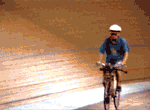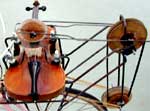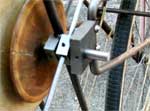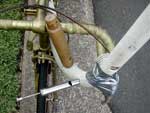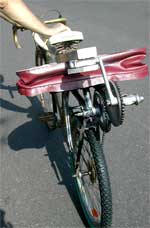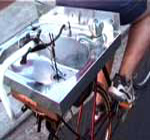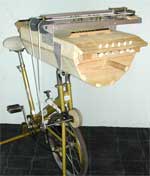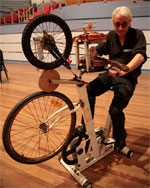 | |||||||

|
Pursuit a project from jon rose |
|
|
PURSUIT 3, The Canberra Pursuit took place on October 18th 2013 at The Fyshwick Depot, Canberra, as part of The Canberra Centenary. It featured a 130 strong bicycle powered orchestra with a crowd of 1,000 in attendance. Imagine the darkened spaces of the huge warehouse and car park at The Fyshwick Depot, Canberra. The audience was assembled at various key points around a cycle track. Around them were speeding bicycles with pedal powered sounds; everything from mechanical whirring violins, to beating drums at impossibly fast tempos, to bellow powered organ pipes, to tuned car horns, to DIY electronic instruments, to a colourful selection of bells and buzzers, to chain driven DJ turntables, to the proverbial kitchen sink! Sometimes there was just one acoustic sound accompanied by the discrete lights of the bicyle. Sometimes there was a whole orchestra of bicycle live sounds, digitally manipulated in quadraphonic surround sound, complete with video and light show. Interactive sensors on bike and track determined other sonic and viseral aspects of the spectacle. PURSUIT 2 took place on January 9th 2010 at The Princes Warf, Hobart, Tasmania as part of The Mona Foma Festival. It involved over 50 members of the community as bike choir, bicycle bell orchestra, and bicycle instrument makers - an audience of 1,500 attended. PURSUIT first took place on February 14th 2009 at The Performance Space Sydney and featured a veritable chamber orchestra of mobile, bicycle-powered acoustic musical instruments combined with the latest wireless transmission technology. The Carriage Works space became the cycle track - a race of speeding sounds - the sound of bicycles singing. The audience was assembled at various key points around a cycle track. Around them and past them bicycle powered sounds moved physically through spacetime at different speeds. Sometimes there was just one acoustic sound accompanied by the discrete lights of the bicycle. Sometimes the live sounds were digitally manipulated in quadraphonic surround complete with bicycle mounted light show. Wireless transmission boxes linked instruments and cyclists to a central mixer and quadraphonic sound system, offering more rotational speeds, sounds in contrary motion, and other options such as pitch shift and live sampling techniques to the pedal powered instruments. Close up images of the instrument mechanics appeared on video screens beside the four speakers. Through an integrated MAX/JITTER system, live sound and action transformed the images into a synchronous experience. Pursuit was a specially-choreographed spectacle of sound, speed and light based on pedal power lasting one uninterrupted hour. Bicycle musical instruments were anything from simple clip on clickers, a range of bells and horns on the handlebars, to more complex constructions with wheel powered wind, string, or percussion actions - even retro-bicycle dynamo DC powered electronics. Our list of bicycle powered prototype instruments included: violins, a viola, bellow powered organ pipes, a revolving bass drum, a DJ turntable, a plastic ukulele, the 2 meter high Grand Fiddle, the biscuit tin (our loudest instrument), the giant spring, the rolling pin, the plectraphone, the mobile cracklebox, the lawn mower, the mega clicker, the green pump, the front-end loading drum, the macaroni mixer, the red funnel, and we include the kitchen sink - transmitted to the big screen by the notorious i-bike which was fitted with accelerometers on wheels and handlebars and was ridden by Australia's very own Penny-farthing champion. The first instrument was called, logically enough, the VIOCYCLE. It is a violin played hurdy-gurdy style with a small wooden wheel geared down to a suitable speed by a set of rollers and belts. A bowing speed lasting two seconds from frog to tip of bow (0.6 meters) was estimated and the gearing set accordingly. Even at a test speed of 15-20 kilometers per hour, phenomena such as phasing, delays, and pitch shift caused by the Doppler effect, are clearly audible and stunningly enhanced by the acoustics of the space. As one can hear from the sound on this page, a doppler shift of a semitone was recorded. The violin sounds pure and is about three times louder than a normally-bowed instrument. The next stage will be to fit guitar machine heads instead of pegs for ease of tuning and re-tuning while underway and to build a simple capo-style system for elementary shifts of pitch - anyone with a good ear is able to ride and play. The second instrument to be tested was the PIPECYCLE. A range of diapason pipes and whistles were powered by a huge set of bellows bolted onto the back of the bicycle. Since initial testing a windbox has been fitted with sliders controlling the airflow to a range of flu and reed pipes - like a simplified church organ mechanism. The summer of 2006/7 saw the transformation of domestic objects into cycle powered musical instruments. (Not quite) everything including the kitchen sink has been applied to cycle technology. The Sink, the Rolling pin, and the Lawn Mower have all been subjected to chains, pulley ratios, and gearing mechanisms. The dynamics of the wheel has remained central to these experiments. Harry has built a unique plectrafone (a cross between a huge guitar and a harpsichord) for use in the Pursuit. Paul has welded two violins, wheels and pulleys to a stationary keep fit bike. In recent months Rod Cooper has been re-designing his bicycle powered DJ turntable and Jim Sosnin has been considering a remake of Alfred Traeger's revolutionary pedal powered generator of 1929 to power our computers used in Pursuit (Traeger's pedal generators were used to communicate with The Flying Doctor Service and The School of the Air). THE INSTRUMENT MAKERS. Harry Vatiliotis is Australia's most known and prolific violin maker with a massive international and local reputation. He has made over 500 excellent classic instruments but is not averse to experimentation; he has built a complete set of ancient Greek harps, and he recently built a superb hybrid tenor violin (The Bird) fitted with four sympathetic strings (in the style of a Hardinger fiddle) for specific string scordatura projects. Paul Bryant earns his living as a family dentist but has a passion for bicycles, violin building (one of Harry's ex-students), metal work and mechanics. Paul is something of a Renaissance man and is ecologically and politically active. He is also a founding member of the NSW touring Bicycle Club and has a collection of 20 seriously used cycles in his shed ... which MUST have some relevance to this project. Jim Sosnin has worked in the field of Music Technology since 1973, initially at Melbourne University's Electronic Music Studio, and later in the Music Department of La Trobe University, where he was involved in Computer Music research. Jim is arguably Australia's most significant innovator in the fields of analog and digital audio, wireless communication systems, and digital signal processing. Over the years he has collaborated with many musicians and artists on their creative projects, providing technical support for various interactive sound installations, performance systems and other sound art. Rod Cooper is an instrument builder, performer, and sound artist. He started instrument building while completing his sculpture degree in 1988. The noisy environment of metal workshops and the sounds of construction developed his awareness for the potential of visual sculptures to become musical objects. Large sound chambers covered with strings and springs produce an acoustic resonance that is large in scale, a sound that Rod equates to the vast spaces of the Australian landscape. Rod performs regularly through out Australia and has toured internationally in the UK, America and New Zealand. Robin Fox and Jon Rose have their own extensive websites. Eh... on yer bike! The purpose of Pursuit is to involve the community in an event with serious social, aesthetic and ecological intent: Pursuit also engages the community in: 1. The transformation of sound at speed. 2. The rhythms and sonification of the bicycle. 3. The necessity of physical action in the experience of music. 4. The relationship of sport to music. 5. The re-cycling of rust and waste. 6. Fun. Previous sport related projects have included: Team Music for interactive netball (NOWnow Festival 2010, Sounds Outback 2008); Duets for violin and amplified squash court and player (Praxis, WA, 1983); Cricket - a musical adaptation of the national sport complete with amplified bat and strung wicket stumps (Performance Space, Sydney, 1986); Perks - an interactive badminton game based on the mind and obsessions of Percy Grainger (Berlin Sonambiente Festival, Brisbane Biennale, Ars Elektronika Austria, Steim Amsterdam, Mousontürm, Frankfurt 1996-7). Then there are some of the specially-built Relative Violins of the early 1980s, such as the Double Piston Wheeling Violin and the Bicycle Wheel-Powered Violin, made to test musical notions of time, distance and speed. JR www.jonroseweb.com |
 |
